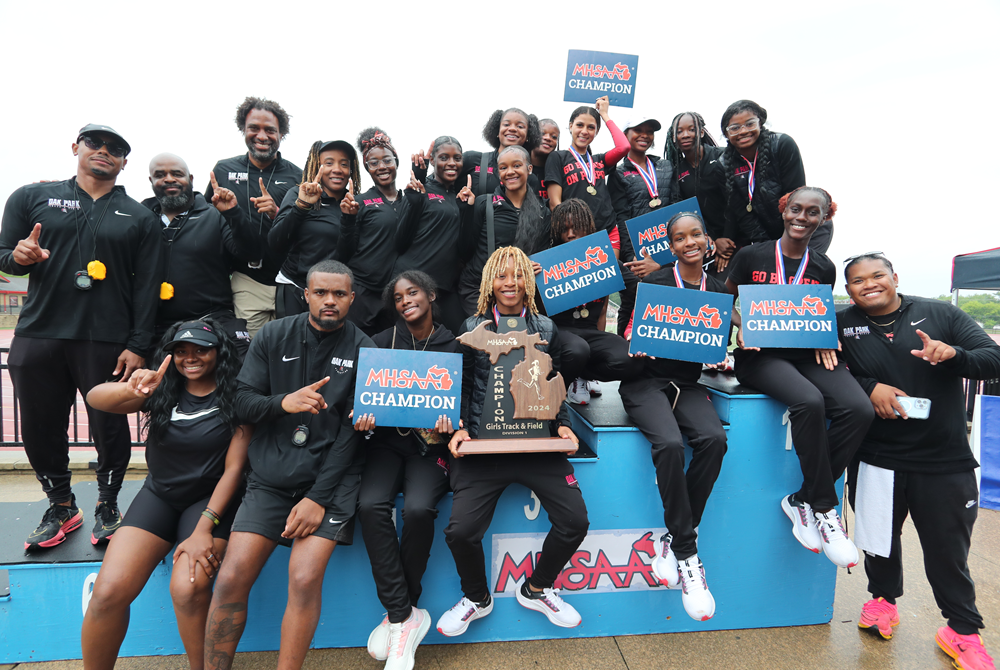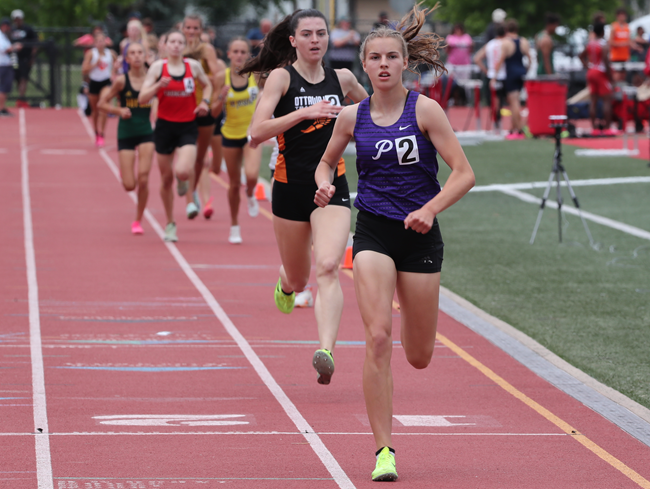
Add, Subtract, Divide, Multiply: MHSAA Not Alone
July 25, 2017
By Rob Kaminski
MHSAA benchmarks editor
This is the third part in a series on MHSAA tournament classification, past and present, that will be published over the next two weeks. This series originally ran in this spring's edition of MHSAA benchmarks.
As the MHSAA faces its most recent classification task with 8-Player Football, and opinions continue to swirl about as to the method, timeframe, location and other procedures, a look around the country provides plenty of company among state association brethren factoring variables into their own equations.
In the Pacific Northwest, the Oregon School Activities Association Football Playoffs are under public scrutiny as leadership ponders a five or six classification format beginning with the 2018-19 school year.
The OSAA has crowned six champions on the gridiron since 2006-07. Many of the state’s smaller schools would like to keep it that way, while larger schools lean toward a five-classification system, citing larger leagues, ease of travel and credibility to state championships as the advantages.
Still others would prefer more than six classes, pointing to safety issues and the opportunity to increase participation numbers as positives.
Moving southeast of Oregon, the Nevada Interscholastic Activities Association recently voted to hold serve on a classification proposal that was volleyed to the membership.
However, changes still could be forthcoming by as early as the 2018-19 season which would add a fifth classification in more populated southern Nevada while allowing northern schools to participate in four classifications. Such divisions could mean no state championship for the fifth class in southern Nevada.
Because of that, the NIAA wants equal numbers of schools in each classification on both ends of the state. Complicating the issue is the fact that the 24 largest schools in the state, by enrollment, are all in Clark County in Southern Nevada.
Across Nevada’s border into Arizona, charter schools are asking the Arizona Interscholastic Association to reconsider classification that was voted upon and approved in September 2015. That agreement called for the largest 33 percent of charter schools by enrollment to be placed in the state’s largest school classification, 3A, the middle 33 percent into 2A, and the smallest 33 percent into 1A.
Less than two years later the charter schools have had a change of heart and have asked to be considered the same as other Arizona public schools and be placed appropriately by enrollment beginning with the 2018-19 school year.
The situation in Arizona further illustrates how the public/private debate that all state associations have faced throughout existence now has the added dynamic of rapidly growing charter schools in today’s educational system, along with virtual school enrollment.
In the nation’s heartland, Nebraska has retooled its football classifications by using enrollment of boys students only in its schools rather than total enrollment. The Nebraska School Activities Association football-playing schools will kick off the 2018 season using this alignment.
Nebraska has three classes of 11-player football, with the smallest class divided in two, Class C-1 and C-2. The state also will have 8-player football for boys enrollments under 47, and the NSAA will sponsor a new 6-player tournament in 2018 for schools with 27 or fewer boys.
“This is a good proposal because some schools have a sizable imbalance between the number of boys and girls, and there’s a large gap (in enrollment) between the largest and smallest schools in Classes A and B,” NSAA executive director Jim Tenopir said. “I think this addresses both of those concerns.”
Swimmers in Georgia, meanwhile, will feel like they are moving with the current, rather than upstream in 2017-18, as the Georgia High School Association recently doubled the number of team championship events from two to four.
Swim enthusiasts can also count on longer days at the finals, as the top 30 finishers from the prelims will advance to the finals instead of 20, and all championship events will have three heats versus two.

Oak Park, Returning Individual Champs Lead Chase Again at Star-Filled Finals
By
Steve Vedder
Special for MHSAA.com
June 1, 2024
Abby Russell has no problem throwing as the favorite with everyone else hoping to catch her.
In fact, the Allen Park senior embraces summoning up her best efforts in both the discus and shot put every time she lines up to throw. Russell said she's never equated success with the pressure of being a state champion.
"To be honest, no," said Russell, who closed out a stellar career by winning those two events at Saturday's Lower Peninsula Division 1 Finals at East Kentwood. "I just focus on myself. Going to see a sports psychologist has helped me a lot with that. We talk about the work you have to put in, and (success) being a consistency thing."
Whether it's pure talent or seeking professional guidance or the ability to deal with pressure, Russell finished off an outstanding career in winning the discus (156-6) and the shot (46-10) on Saturday. The two titles are added to a first as a sophomore and third as a junior in the shot. She's now a three-time champ in the discus.
The wins at East Kentwood were also personally rewarding to Russell, who didn't place in the shot as a freshman at Falcon Stadium. It's one of the few places where the University of Michigan-bound Russell figures she could have done better.
"I was real bad as a freshman, so I was happy to get back here again," she said. "I had a great time back then. I just didn't do what I wanted."
While Russell was among those dominating the individual meet Saturday, Oak Park was sweeping its way to a team title. The Knights finished with 88 points to easily outdistance runner-up Ann Arbor Pioneer's 42. Detroit Renaissance was third with 35 points, East Kentwood was fourth with 34 and Saginaw Heritage had 30.
Oak Park coach Brandon Jiles, whose team collected its eighth Finals title under his leadership, said he wasn't sure what type of showing a young team would make Saturday. Of the 35 athletes on the roster, just three are seniors.
Still, Jiles thought the team would be in the hunt along with Pioneer, Renaissance and Detroit Cass Tech. At least part of the success was winning the 800 (1:38.10), 400 (47.53) and 1,600 (3:47.99) relays. The other firsts were by senior Morgan Roundtree in the 300 hurdles (41.31), freshman Nevaeh Burns in the 400 (55.02) and senior Kylee King (2:10.53) in the 800.
 "We thought we had a shot. We just take it one event at a time and do what we have to do. We only have three seniors, but they're really good kids. We'll have some good girls back next year, and they know they'll have to step up and score," Jiles said.
"We thought we had a shot. We just take it one event at a time and do what we have to do. We only have three seniors, but they're really good kids. We'll have some good girls back next year, and they know they'll have to step up and score," Jiles said.
"I'm a very competitive person when I see other teams that are good. I think the girls are like that too. We're ready when it comes to championship time."
Roundtree said her two chief goals at the meet were accomplished. She wanted to join a long list of successful Oak Park sprinters while also leading a young team to a championship.
"I want to motivate my teammates, and I think I was able to do that," said Roundtree, whose 300 time is ninth best in the country. "We've had some good sprinters here, and I really wanted to become one of them."
Among the other champions was Lena Cleveland of Rochester, who went from finishing fourth in the long jump a year ago to winning (18-2) that event Saturday. Cleveland is a former sprinter who traded the 100 and 200 for the long jump a couple of years ago.
"I wanted to try the long jump, and it's worked out," she said. "I put in a lot of hard work over the summer and in indoor. I also worked hard in strength training in the gym. I didn't used to have access to a (long jump) pit, but I was able to put in the work."
Rachel Forsyth of Ann Arbor Pioneer won the 1,600 (4:38.28) and 3,200 (10:15.57) to cap an outstanding four-year career. A two-time cross country Finals champ, Forsyth overcame illness to win the 1,600 a year ago. She was coming off a trip to the Trial of Miles meet in New York a couple of weeks ago, but said the Finals featured virtually no mental letdown.
"Maybe a little, but you can't control it," she said. "You can only control what you're doing that day. And I think I ran well. It was great because my sister was in the same three events I was in in 2017."
The other champions Saturday were Kamryn Tatum of West Bloomfield in the 200 (24.63), Brooke Bowers of Grand Rapids Forest Hills Central in the pole vault (12-9), Madison Morson of Salem in the high jump (5-10), Maya Rollins of Ann Arbor Pioneer (13.86) in the 100 hurdles, Willow Mason of Saginaw Heritage in the 200 (24.66) and Keyanna O'Tey of Sturgis in the 100 (12.08). West Ottawa won the 3,200 relay (9:00.27), and Fenton sophomore Molly Katic (100), Clarkston freshman Allison Thurman (200) and Sturgis freshman Vivian Massey (shot put) were the adaptive event champions.
PHOTOS (Top) Oak Park celebrates its latest LP Division 1 team championship Saturday at East Kentwood. (Middle) Ann Arbor Pioneer’s Rachel Forsyth leads the pack in the 1,600. (Click for more from John Brabbs/RunMichigan.com.)

